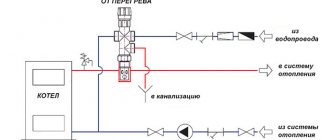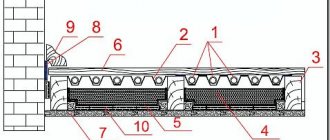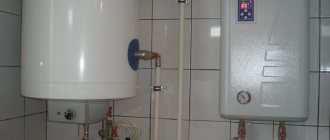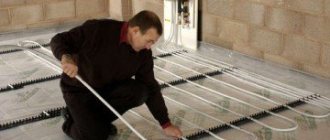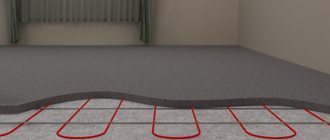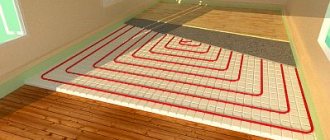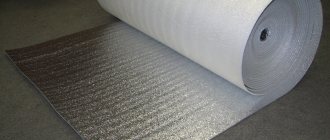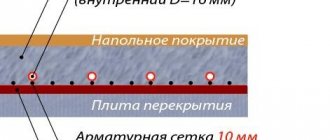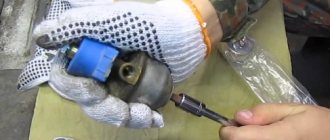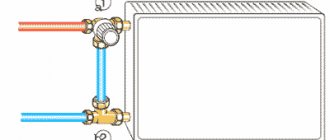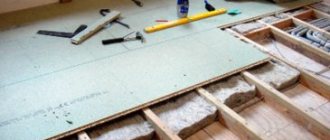What is it and what is it for?
The optimal modern heating method is to install heated floors in the house. A warm floor allows you to evenly heat the entire room from below and not waste heat on heating the air under the ceiling, heating only the necessary rooms or even their individual areas. Heating using a heated floor system allows you to save up to 30% on fuel and finances compared to floor and wall heating.
The heated floor system uses a coolant with a maximum temperature of +45 °C, and boilers heat the coolant to a temperature of 80...90 °C. Therefore, to ensure the required coolant temperature, a device is needed that mixes hot water from the boiler and cold water from the return. It is very important for the floor not to exceed the temperature of the coolant. A three-way mixing valve is used as this device in the manifold assembly.
Purpose and scope
A three-way valve is used to regulate the temperature of the coolant in pipelines embedded in the floor screed.
Warm floors are not yet very widespread in our country; they are mainly installed in private homes. But people are gradually realizing the reliability of this heating option and seeing savings, and heated floors are gradually gaining popularity in both public, office and administrative buildings.
If you weigh all the pros and cons of using underfloor heating, the significant savings outweigh the high cost and complexity of installing the entire system.
Characteristics
Features of mixing valves include:
- Control method: mechanical or electric drive.
- Diameters of pipes.
- Operating pressure. All three-way regulators are designed for a pressure of at least 1.6 MPa, and in a private house in a floor heating system the pressure does not exceed 0.2-0.3 MPa, so when purchased, any valve with a nominal pressure is suitable for a private house.
- Bandwidth.
What materials are they made from?
Three-way mixing valves are made from the following materials:
- Brass. The copper alloy with the addition of zinc is not subject to corrosion, brass fittings are strong and durable. Sometimes brass products are coated with chrome or nickel for aesthetic purposes, since the metal darkens over time. This is the most common material for heating control devices in residential buildings.
- Bronze. Also an alloy of copper with tin, aluminum, silicon, beryllium. The quality is not inferior to brass, but is rare.
- Stainless steel. Excellent material for control valves. Its durability, corrosion resistance and strength are higher than that of brass. But stainless steel is more expensive, and it makes no sense to use such regulators in a private home.
For three-way control valves, titanium and carbon steel with a protective coating are also used, but these are rather options for industry. Ceramics are not used; they cannot withstand endless operation. Occasionally there are cheap products made from silumin - an alloy of aluminum and silicon. The quality of silumin products does not stand up to criticism - they fail very quickly.
Almost always, brass three-way valves are used for installing underfloor heating systems in a private home.
Criterias of choice
The technical characteristics of a three-way device have a significant impact on the quality of underfloor heating. Therefore, when selecting a valve, it is worth considering the following indicators:
- The volume of the heated room. Heating large areas requires the installation of a three-way valve with automatic regulation, which independently controls the temperature of the coolant entering the pipeline of the floor heating system. For small rooms there is no need to buy expensive mixing devices with a complex design. A simple valve is suitable for heating balcony rooms, bathrooms and small corridors.
- Throughput indicator. The maximum level of liquid pumped by the mixing valve is determined at the beginning of the design of the floor heating system. The three-way valve must meet the established flow rate, otherwise the device will not withstand the pressure load.
- Cross section diameter. This parameter is necessary to connect the mixing device to the heating system. If necessary, special adapter devices are used that allow precise connection of devices.
- Material of manufacture. The valve must be made of metal that has a low expansion coefficient and does not change its original characteristics when interacting with a hot coolant. Three-way valves made of bronze and brass have these properties.
It is recommended to purchase mixing devices from trusted manufacturers. The product must be accompanied by warranty documentation, instructions with the specified technical characteristics and a quality certificate.
When choosing a three-way valve, consider the flow rate
Before installing a three-way valve in a heated floor system, you should check the device for functionality. To do this, set the control ring to the lowest temperature value, and then pass a hot stream of water through the valve. A properly functioning device should immediately close the hole.
Operating principle and device
To regulate the degree of heating of the coolant in a heated floor system, a three-way mixing valve is used, which has one output and two inputs. Operating principle: two streams enter the device - hot and cold water - and are automatically mixed in a certain proportion.
The proportion is determined by the thermostat setting. The valve does not change the pressure in the pipeline (except for minor losses when water passes through the fittings). There are models with an electric drive - they allow you to very accurately regulate the temperature of the coolant.
The valve design includes a body, control elements (spools) connected to the stem, a thermal head that controls the stem and, through its movement, the spools. The body has seats with seals. When the rod is turned, the spools rigidly connected to it slightly open or shut off the flow of cold or hot water, changing the temperature of the water at the outlet of the valve.
The rod is turned by a thermal head, which is triggered when the temperature of the outgoing coolant rises and falls. Electrically driven devices are triggered automatically: it turns on if a command is received from temperature sensors.
There are three-way valves, the design of which is based on a ball valve. The regulatory body here has the shape of a ball or sector with a hole of complex shape. The rod in such drives rotates.
Methods of use
The three-way valve can be installed either in the mixing unit or without it. In the second case, the device completely takes over the collector function.
Installation of a tee for adjusting the water temperature of a heated floor without additional mixing devices is carried out in rooms whose area does not exceed 25 square meters. The supply of liquid at the desired temperature is carried out through a control device and a thermostat installed in the valve itself.
Installation according to this scheme is suitable for bathrooms, toilets and balconies. The disadvantage of installing a three-way valve as the main device for mixing hot and cold coolant is the inability to dose flows.
When installing a floor heating system for large volumes of living space, a three-way valve is a component of the manifold group. In such cases, the device ensures a complete uninterrupted process of all heating equipment. Due to it, liquid at the required temperature enters all circuits of the floor heating system.
The three-way valve is effectively used in facilities with a large area - more than 200 square meters. In this case, the warm floor can operate both from an autonomous network and from a central heating system.
Advantages and disadvantages
Advantages of three-way mixing valves:
- Simple design.
- Stable regulation.
- Reliability.
- Tightness.
- Sufficient adjustment accuracy (maximum accuracy – up to 1°C).
- Durability.
- Relatively compact dimensions.
The biggest advantage of using three-way valves is that the pipelines and, accordingly, the screed and floor covering do not overheat, which prevents premature failure of the screed and coating.
Flaws:
- The hydraulic resistance of three-way designs is higher than that of a conventional two-way valve.
- The design of the body and spool allows for the presence of stagnant zones - periodically you will have to dismantle the device and clean it of scale, debris, and organic impurities.
- Insufficient accuracy of room temperature control. The control valve quite accurately regulates only the temperature of the outlet coolant, and the temperature of the heated room - approximately.
To ensure a comfortable level of heating, you will have to select the ratio of the temperature of the outlet flow and the temperature in the room “at random”. Unfortunately, the underfloor heating pipelines are much larger than the radiator, and it is impossible to ensure accurate adjustment. The situation is further complicated by the inertia of the heated floor - a 100-mm cement screed warms up very slowly.
But if you are stoic about slowly heating or cooling a room, then a valve with mechanical adjustment is quite suitable for use in the heating system of a private house or apartment.
Much greater comfort is provided by electrically driven valves controlled by a smart home system with temperature sensors in each room. But such devices are very expensive.
Types and their structure
In a thermostatic distribution valve installed on a heated floor, the heated water is mixed with cooled water from the return pipe. This process is continuous as long as the heating is on.
There are two-way and three-way mixing valves for underfloor heating. They also differ in the method of mixing and the direction of flow.
Two-way
The two-way thermostatic valve is an improved manual type model. It can be hydraulic, pneumatic or electrically driven.
The design is simple, but capable of effectively regulating the temperature level of the coolant in automatic mode. The device is mounted in the heating system, instead of a manual valve.
Main advantages:
- Automatic reduction of liquid temperature level;
- Simplicity of design and low price;
- Easy installation.
Disadvantages - the possibility of installing it on pipelines with a small size. If you use this faucet when installing heating in a room with a large area, the thermostat will function intermittently. A two-way valve is more often used if heated floors act as additional heating.
The valve device is a brass or bronze body, with one or two seats. A double-seated valve can completely shut off the flow of water.
The device is equipped with a thermostatic head with a scale. The head position can be changed manually or automatically. Manual models are simple and inexpensive. More modern devices work automatically.
The two-way valve operates according to the following principle - the coolant from the return line is again supplied to the floor pipes, but before this, a device is activated that opens the supply of heated water. The two flows are mixed inside the housing to the desired degree, then the temperature sensor is triggered and the shutter automatically closes the hole with the hot coolant.
The valve consists of a plunger and a seat. The plunger has a disc, needle and rod shape. It is located perpendicular to the movement of the fluid.
Three-way valve
The operating principle of a three-way thermostatic valve for floor heating is that cooled water from the return line is added to the hot water coming from the boiler.
The valve is designed for heating systems that are installed in large rooms. They have the same advantages as two-way valves. Particularly worth noting is the ease of adjusting the water temperature for heated floors.
But this thermostatic valve also has a minus - if the thermostat is triggered, the valve opens completely, thereby allowing hot coolant to enter the circuits. And this can cause overheating of the heating system, and even rupture of pipes. In addition, it has a lower flow capacity than a two-way valve.
Three-way thermostatic mixing valves are available in brass and bronze. They are equipped with a thermal head or thermostat, and can have an electric drive or a servo drive. The design is a faucet with two inlets and an outlet. Inside the case there is a mixing chamber, on which there is a thermostat with a regulator on which there is a digital panel. A thermal valve is connected in front of the manifold.
Operating principle of three-way thermostatic valve:
- heated water moves through the right and front pipes - if its heating degree meets the required parameters;
- if the temperature of the liquid increases or decreases, the thermostat comes into operation, it sets the rod in motion, as a result, cooled water is mixed with hot water;
- after reaching the set temperature, the front hole opens completely.
It should be said that when the device is turned on, the water flow voltage does not change. This leads to a uniform change in the temperature of the liquid supplied to the line.
By mixing method
Mixing taps for heated floors, depending on the mixing method, are:
- With a thermostat function - with it it is possible to achieve and maintain the desired degree of heating of the coolant, since the device is able to regulate both flows (heated and cooled). The thermostat in the mixer, reacting to the level of heating of the liquid, opens or closes the hole through which heated or cooled coolant is supplied. In addition, the mechanism is designed in such a way that in the absence of cold water, the automation shuts off the flow of hot water.
- Thermostatic - the device is equipped with a sensitive thermal head that has an external temperature sensor, it is located in each line. The operation of the valve is to determine the water temperature and send a command to the actuator.
Kinds
Three-way valves are classified according to their operating principle. There are separation and mixing valves. Heated floor systems (and radiators) use mixing devices that regulate the temperature of the outlet coolant by mixing cold and hot water.
According to the method of actuation, three-way devices are:
- Manual. They are very rare and inexpensive. Convenient if heated floors are installed in 1-2 rooms - for example, a bathroom and a children's room.
- Automatic.
In manual modes, the position of the rod and the temperature of the outlet water are adjusted manually using a handle. In automatic ones, the movement of the rod is controlled either by a thermal head or by an electric drive controlled by automation with temperature sensors.
Automatic valves are:
- The simplest type is with a thermostatic head. They are triggered when the temperature increases (they react to an increase in pressure). Such devices are used for radiators. The fluid in the actuator expands as the temperature increases and drives the rod.
- With thermostatic head and remote sensor.
- Electrically driven. The rod is driven by an electric motor. The engine is controlled by a controller that receives signals from temperature sensors. The actuator can control the valve using a solenoid (magnet) or a mechanical transmission (servo).
- In production, systems with large pressures and diameters use pneumatic or hydraulic drives.
Types of valves are shown in the photo:
Valve markings
Three-way valves are marked with letters and numbers:
- Company name.
- Series and model number (for example, VTA 321).
- Nominal diameter in mm (DN 20).
- Temperature regime, for example 20-45C - regime from 20 to 45 °C.
- Throughput in m³ – KVS 1.6 – 1.6 m³/hour.
An example of an ESBE valve marking looks like this:
ESBE VTA 321 DN 20 20-45C, kvs 1.6
Standard sizes: ½", ¾", 1″, 1¼" and so on, or in mm - 15, 20, 25 mm, etc.
Place and role of mixing valves in the heating system "warm floors"
The main task that consumers have to face when deciding to install heated floors in their home is to achieve the required coolant temperature. For radiators, water at a temperature of 750C is quite acceptable, which cannot be said about pipes that are laid in the thickness of a concrete screed.
Important! Excessive heating of the concrete screed leads to a deterioration in the temperature balance inside the heated room. At high temperatures, flooring (in most cases wood-based) quickly loses its aesthetic and technological qualities, becoming unusable.
In accordance with sanitary standards, the normal heating temperature of heated floors should not exceed 260C. Then the middle layers of the air mass inside the room warm up to comfortable values of 20-220C. In order to obtain such temperature parameters, the water entering the loops of the water circuit must be heated to 500C. Slightly less than 50% of the thermal energy of the heated water is spent on heating the layered cake of the heated floor. Taking into account the thickness of the concrete layer, material and type of floor covering, the temperature on the floor surface decreases.
A mixing unit, which is a set of interconnected instruments and devices, helps to achieve a significant reduction in the temperature of the boiler water at the entrance to the heating water circuits. One of the main roles in the operation of the mixer is played by the thermomixing valve, which mixes water for the heated floor. Thanks to this small device, two streams of water are mixed, cold and hot, so that the output is water at the required temperature. Valves installed in mixing units are of two types, three-way and two-way. Each type of crane performs its own tasks and functions determined by the technological process. Which device is best to use for your heated floors? What is behind the choice of the type of mixing and control device?
How to choose
Installing a heated floor, even in a private house, is a rather complex engineering system with ambiguous results. If the adjustment is poor, all the benefits may disappear, so you cannot save on the manifold assembly and control valves. Good three-way valves are not cheap, and there is a high probability of purchasing low-quality products on the market or on the Internet.
For a heated floor system, it is better to buy equipment in a hypermarket or specialty store. A certificate is a must! Or a passport with a “wet” stamp and a completed guarantee. The receipt must be kept.
Usually they buy products made of brass. Stainless steel valves are more expensive and less commonly sold. Silumin is not even worth considering - products made from it do not tolerate constant opening and closing, and the control valves cost a lot.
When purchasing in a store, you need to inspect the valve to ensure there are no chips, cracks, or jams. You need to try to look inside the valve - on brass products without coating, the inside should be golden (and not white-silver, like silumin). You can navigate by weight. Silumin products weigh much less than brass ones - the density of brass is approximately three times greater than that of silumin.
Popular manufacturers
In first place in terms of quality are the products of the Swedish company ESBE. The company has been producing pipe fittings for various purposes for over a hundred years. The second place is occupied by the American company Honeywell. Fittings from HEIMEIER, HERZ, Navien, Danfoss, Mut, Oventrop, Siemens are common. The cost of these products outstrips the quality. The products of the joint Italian-Russian manufacturer Valtec have a more reasonable price.
approximate price
The table above is the prices for a Three-way valve with a thermal head. To find out how much equipment costs in your region, it is better to contact the nearest construction hypermarket. Approximate prices for a three-way valve with electric drive:
How to choose a valve for a heated floor?
The popularity of water floors, which are increasingly used for heating private houses and country cottages, has given impetus to the emergence of a huge selection of models on the market. But here the question arises: which three-way valve to install on the heated floor, which manufacturer to choose. After all, the abundance of goods makes shopping difficult. When selecting a device, experts recommend deciding in advance what type of device is needed—two- or three-way. Then select the manufacturer:
- Valtec. The company presents Russian-Italian products on the market. Their main advantage is a budget price with excellent physical and technical qualities. The manufacturer provides a 7-year warranty on the purchased three-way valve for heated floors with a thermostat. The products are supplied with quality certificates, technical data sheets, installation recommendations and a warranty card.
- Esbe. The Swedish company offers high-quality underfloor heating taps made from innovative materials. The devices are maximally resistant to operating conditions, reliable and visually attractive. When purchasing Swedish devices, it is recommended to carefully consider the technical characteristics of the equipment. There is a small chance that the parameters will not match. The cranes are supplied with certificates and warranty cards, the service life is over 5 years.
- Honeywell. The thermostatic mixing valve for underfloor heating from the American company Honeywell is distinguished by its high technology and excellent design. The main advantages of its products are practicality and simplified installation. The design is designed in such a way as to make installation of the equipment as easy as possible. Errors are excluded. The company is proud of its innovative developments, which it implements in the manufacture of devices. This makes them more efficient and reliable, but also more expensive.
From the listed manufacturers, consumers buy time-tested three-way valves for underfloor heating. But you shouldn’t rely only on the quality of the equipment, because even the most stable and reliable device will not be able to protect the system if it is installed incorrectly. In this case, the choice should also be based on the throughput of the unit. This parameter should be clarified in the technical documentation for the equipment. When designing a system for auxiliary heating of air masses from below the room, its power, throughput, heat loss, etc. must be calculated.
Installation and operation rules
Installing a three-way valve into the underfloor heating system of a private house is not too complicated; it can be done with your own hands. It is necessary to strictly follow the instructions, which are supplied by the manufacturer with each product.
The following letters are stamped on all inputs and outputs of the three-way valve:
- A – supply of the main coolant (hot water). Usually this section is on the same axis with the outlet pipe.
- C – second input to the valve. Usually located perpendicular to the axis of movement of the coolant.
- AB – exit. Located on the same axis with the main input.
When installing equipment, it is necessary to provide for the possibility of dismantling and inspection - there must be free access to the valve.
Required tools and materials
To install a three-way valve you will need:
- Two adjustable wrenches.
- American union nuts equipped with gaskets.
- Possibly FUM tape.
Work progress
The valve is installed in the system using American union nuts. Before installation, clean the ends of the pipes (more precisely, the fittings at the ends of the pipes) from dirt, burrs, sand, and dust. The same is done with the valve pipes. Check the presence of gaskets in the nuts. Screw the nuts onto the pipes and tighten slightly. In this case, tighten the nut with one wrench, and hold the valve with the second. A mechanical filter must be connected in front of the valve.
It is important to position the valve correctly: a hot water pipeline is connected to input A; B – bypass from the return; AB is the collector to which the heating pipelines are connected.
When installing, the actuator must not be above the valve.
Installation video
In the video you can see all the intricacies of the correct installation of a three-way valve for a heated floor.
Features of operation
It is imperative to install a filter in front of the valve.
It would be a mistake to install a valve with a thermal head in a system that regulates underfloor heating in several rooms or is located in another room (and in a tightly closed distribution cabinet). It is necessary to install equipment with remote sensors located in a heated room.
Frequent errors and problems during installation
The most significant mistake when installing a three-way control valve is to incorrectly connect the pipelines with incoming and outgoing coolant (for example, when a pipe for supplying coolant to the heating circuit is connected to the inlet pipe). You must be careful when installing equipment. The letters on the pipes indicate the purpose of each outlet; if connected incorrectly, the three-way valve will not work.
It is necessary to strictly follow the manufacturer's recommendations for the length of straight sections before and after the valve, otherwise the operation of the regulator will be impaired, and the warranty does not apply to such equipment.
Installation Features
A three-way valve is most often included in a mixing group, which, in addition to the valve, includes:
- check valve;
- circulation pump;
- temperature sensor.
According to this diagram, installation is performed in the following order:
- a pump is installed on the supply, which pumps hot water heated by the boiler;
- after it comes a temperature sensor that determines the heating level of the coolant;
- then a three-way valve is installed to mix the flows to a given temperature.
- a valve with an outlet is fixed on the return circuit and connected to the cooled coolant entering the three-way mixing valve.
As a result, the coolant with the temperature required for uniform and efficient heating enters the water heated floor pipeline.
If it is intended to install a floor heating system in small rooms, then the installation of a three-way valve is carried out without a mixing unit. The installation sequence of the mixing device in this scheme is somewhat different:
- a three-way valve is attached to the hot liquid supply from the boiler;
- after it a temperature sensor is installed;
- then a circulation pump is installed that delivers water with an adjusted temperature to the heated floor circuit.
Three-way valves can have different hole patterns. The design features of the product depend on the direction of the coolant. According to this, there are two main models of mixing valves:
- L-shaped. The device has two side openings and one circular opening in the lower part of the body. During the operation of the system, hot coolant enters from the side and mixes with cooled liquid supplied from below. Water of the required temperature enters the circuit through the second side opening.
- T-shaped. According to this scheme, hot and cold coolant enters the valve into holes located on the sides of the housing. After mixing the hot and cold flows, the liquid enters the underfloor heating pipeline through the central outlet opening.
Three-way valve for heated floors T-shaped
During the operation of the heating system, liquid heated to 80 degrees is supplied to the three-way valve. After mixing, the water circuit is filled with coolant with the optimal temperature for heated floors - 40 degrees.
The most effective is the installation of a three-way valve with a mixing unit. This scheme ensures uninterrupted and completely uniform heating of the entire floor surface.
Expert advice
Before choosing control equipment, you need to decide what area needs to be heated. If you will be heating a bathroom, part of the floor of a bedroom or a children's room, there is no need to purchase fittings with a thermal head - it is easier to use a manually operated three-way valve than to install a full-fledged expensive mixing unit.
The cost of a mixing and distribution unit with shut-off and control valves, a manifold, a pressure gauge, and a Mayevsky tap exceeds the cost of all pipelines (if they are made of polymer and not expensive copper).
If the underfloor heating system includes several rooms, then it is necessary to order a project from a qualified plumbing engineer before installation - it will indicate the characteristics of the valve. If there is a large area of heated floors and a large number of rooms, one or more mixing units will be needed.
The connection diagram of each unit includes a manifold - a distribution comb, to which heating pipelines are connected. A three-way mixing valve and pump are installed in front of the manifold. The valve can be with a thermal head or with sensors, a controller and an electric drive.
Connecting a heated floor to the boiler
- There are 2 heating schemes:
- combined , when the heating system contains radiators in addition to underfloor heating;
- and heating is only underfloor heating .
With a combined heating scheme, there must be a mixing unit (three-way valve and circulation pump), since the temperature of the coolant in the radiator circuit (70°C) is significantly higher than the temperature of the heated floor circuit (30°C). The boiler heats the coolant to a temperature of 70°C, which is directly supplied to the radiator circuit. And for the heated floor circuit, cold return is mixed with the coolant coming from the boiler so that the temperature at the inlet of the heated floor circuit is 30°C.
- When heating only underfloor heating, you can use:
- An ordinary gas boiler (discharging high-temperature coolant into the system), but only paired with a mixing unit.
- Gas boiler with “warm floor” mode . But keep in mind that in low-temperature mode the heat exchanger will fail very quickly.
- Condensing gas boiler. Low temperature mode is optimal for it; it is in this mode that the boiler has maximum efficiency. But the price is 2-3 times higher than regular models.
The price of a condenser is two ordinary ones, it seems to me that the benefits of a condenser are completely killed by the difference in price.
The use of a condensing boiler for underfloor heating was discussed in great detail on the forum.
Connecting the heated floor to the boiler can be done independently. Before connecting the heated floor to the boiler, it is necessary to install a manifold cabinet and, in fact, install the warmest floor with water circulation heating.
As a rule, the system is connected to a wall-mounted gas boiler. The manufacturer does not matter in this case, because The installation process and operation of all boilers follows a similar principle. It does not matter whether the floor system is connected to the boiler or whether you have a radiator heating system at home.
However, in the case of a warm water coating, the connection is usually made to the boiler.
The conclusions are as follows: hot water output from the equipment into the heating system (supply), output from the equipment into the hot water supply system, gas supply, cold water input and “return” from the heating system.
The boiler used in such systems has 5 outputs (if the equipment is double-circuit, that is, for a hot water supply and heating system).
When connecting to the boiler, you must pay attention to the fact that all connections of the manifold to the heating equipment are detachable: using combination couplings and union nuts.
A ball valve is installed on each pipe. Any equipment of this type has a make-up tap for replenishing/filling the heating system from the water supply system.
To independently connect the heating system to the boiler, you need to prepare a set of simple tools.
- You will need:
- tape measure - 5-7 m;
- pliers (pliers);
- level;
- adjustable wrenches;
- regular wrenches;
- Screwdriver Set;
- sander;
- soldering iron;
- perforator;
- gas-burner;
- pipe cutter
Manifold diagram for connecting a heated floor
The whole process of independently connecting the floor to the boiler comes down to the fact that it is necessary to connect the pipes with the collectors, and connect the collectors themselves with the pipes that come from the boiler. As already mentioned, before connecting the heated floor to the heated equipment, the manifold cabinet must be installed and the floor itself must be laid.
The manifold cabinet must be located in such a place that the supply and return pipes can easily enter it. It is necessary to connect the side outlets of the collector to the pipes for the “return” (return) and supply.
However, before this, shut-off valves (stopcocks) must be installed on the collectors. The shut-off valve may include a thermometer for easier temperature monitoring.
It is advisable to purchase a ready-made manifold set from a well-known manufacturer, which includes shut-off valves not only at the return and supply outlets, but also at all outlets for installing coolant pipes of the heated coating. This will make it possible to turn off 1 separate circuit of the entire system for repairs, so that the others continue to work at this time.
Pipes, taps, and manifolds are connected to each other using compression fittings. The connection of underfloor heating pipes to collectors can be made using special connectors. The connector includes a clamp ring, a support sleeve and a brass nut. When connecting different diameters, adapter fittings are used.
The simplest design option will consist of simple manifolds with shut-off valves. The return and supply are connected to pipes and shut-off valves, and the collectors and coolant pipes of the water coating are connected. This completes the installation of the heated floor system to the boiler.
Complete manifold system
A complete manifold system includes, in addition to shut-off valves on the pipes, a three-way mixer (or pump-mixing unit), an air vent, a drain valve, and a circular pump to facilitate the circulation of coolant in the pipes.
Inlet and outlet shut-off valves can be replaced with thermostatic control valves. They are equipped with a thermal cylinder with paraffin, through which the throughput of the valve is set.
The pumping and mixing unit is necessary to mix the cooled coolant from the return into the supply, reducing the temperature of an overly hot liquid.
People who live in regions with cold climates definitely need a mixer, because the equipment will operate in high heating mode, and the temperature of the heated water coating coolant should be no higher than 55 degrees.
The mixing pump is installed between the supply pipe and the supply manifold. The third output of the pump goes to the return line before the return pipeline. The pump will thus take the coolant at the minimum temperature and add it to the supply.
Three-way valve for heating with thermostat: principle of operation and purpose
Thermostats are installed on radiator passage plugs. If necessary, these devices completely or partially block the coolant flow. The same function is performed by a faucet, however, if you have a thermostat, you set the necessary parameters once, after which the thermal valve maintains the set temperature on its own. Electronic thermal valves provide the greatest accuracy and functionality.
It is important to understand that the thermostat is not capable of changing the initial power of the heat source, but it allows you to wisely manage thermal energy and create comfortable conditions in the room
The principle of operation of the thermostat
The temperature regulator is a two-way device consisting of two main parts:
- valve ("valve");
- thermal head.
Thermostat device:
| Element | Function | Device | Operating principle |
| Valve | Locking mechanism | Consists of a seat, cone and stem. | The operating rod retracts, reducing the distance between the seat and the cone and thereby reducing the flow. As the distance between these parts increases, the flow, on the contrary, increases. |
| Thermal head | Rod control | A heat-sensitive substance is enclosed in a “bellows” (special cylinder). | The operating principle is based on the expansion of gas and liquids when heated. Under the influence of hot coolant, the substance in the bellows expands, pushing the spring-loaded piston. It acts on the rod with a cone in the direction of the seat. When the coolant flow decreases, cooling occurs and, accordingly, the volume of the active substance decreases. The spring returns the piston, cone and rod to their place, and the flow increases. Repeating the cycle allows you to regulate the degree of heating of the radiator with high precision. |
Types of thermostats for radiators
There are several types of classification of thermostats for three-way valves.
Classification of thermostats according to the method of setting the temperature and controlling the temperature regime:
| Thermostat type | Peculiarities |
| Mechanical thermostats | Presetting the device is done using a handle with divisions. The rod is driven by a bellows and a return spring. |
| Manual thermostats | The operating principle is similar to a regular faucet. This model can be easily replaced with a regulator for automatic operation of the valves under changing conditions. |
| Electronic thermostats | They have a digital panel. The energy source is batteries. The temperature of the coolant is taken into account. Allows you to program the mode by time. |
Manual and mechanical thermostats can be divided according to the type of active substance in the bellows. Liquid or gas can be used as a heat-sensitive substance in the bellows; accordingly, thermostats are:
- liquid;
- gas.
Thermostats are also divided according to their purpose. Depending on the features, thermostats are designed:
- for two-pipe distribution systems;
- for single-pipe distribution systems.
According to the connection method, thermostats are:
- corner;
- straight.
